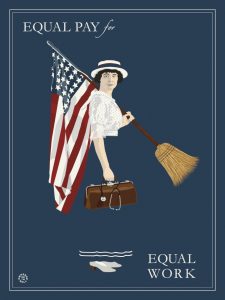Artist Meneese Wall Finds the Living Spirit
By Julie Mackaman

Photo by Kerry Scherck
The images created by New Mexico artist Meneese Wall became the visual touchstone of our branch’s year of Women’s Suffrage Centennial programming in 2019-20. At every meeting we sold notecards carrying her singular artwork on the front (and her scrupulous research on the back), helping our members and the public see the movement’s leaders — from Susan B. Anthony, Elizabeth Cady Stanton and Sojourner Truth to Carrie Chapman Catt and Alice Paul — as we had never seen them before. I reached Meneese, whose Irish family name rhymes with “Denise,” in her Santa Fe home in July, and asked her about her background as an artist and how Women’s Suffrage and then the Centennial became an inspiration for her work.
She says she has always been an artist, having “popped into the world” with a sense of aesthetics shared by a family who believed that “life is more truly felt when wrapped beautifully.” Meneese traces her work as a graphic artist, writer and entrepreneur to a lifelong fascination with style and fashion, with interior design and architecture. Her parallel interest in history, evident in her personal collection of Fortune and Vogue fashion illustrations from the 1910s-1930s and her research into stories that spark her curiosity, gives her artwork and writing their distinctive signature.
Her work has appeared in magazines, books and online journals, many related to social issues. Meneese’s new book, We Demand the Right to Vote: The Journey to the 19th Amendment, released in August 2020, is lauded as the sole book to provide an illustrated overview of the 72-year march toward women’s suffrage in the U.S. It incorporates the images and research that made the posters and notecards in her Women’s Suffrage Centennial collection popular nationally — and with our branch.

© Meneese Wall
I asked Meneese to walk me through the development of a single image that appeared on one of our branch’s best-selling and timely cards, “Equal Pay for Equal Work.” She explained that this demand for parity was an integral, unifying force behind the suffrage movement, as it spoke then — as it does today — to women’s economic independence and potential. Many of the movement’s women (“domestic divas”), frustrated by laws and social norms that relegated them to the home and deprived them of property and other legal rights, were galvanized by the demand for economic equality. “And here we are, still talking about equal pay,” Meneese observed.
The striking image is steeped in an aesthetic at once nostalgic and futuristic. A summertime study in patriotic blue, white and red, it portrays a woman dressed in the long skirt of a bygone era, a white blouse with rolled-up sleeves, white pumps and a straw hat. Her challenge to the U.S. government is implicit but unmistakable: the broom that rests on her left shoulder serves as a jaunty flagpole for the Stars and Stripes, and her right hand grips a doctor’s bag. We are Americans too, her stance seems to declare, and we’re not going away until we get the same rights you have.
Meneese said she drew aesthetic inspiration from American illustrator Coles Phillips (1880-1927) when she used a field of blue, with the woman’s dress dissolving into the background, to foreground the doctor’s bag. While other of Meneese’s illustrations portray Black suffragists, she made this woman white as a visual parallel to the white lawmakers the movement confronted. The woman has turned her head to look at the viewer, who may equally be the lawmaker of then or of now, as well as at the generations that will carry the movement forward.
A graphic artist, Meneese does not draw but uses technology to create her images. She says she appreciated the challenges presented by this particular image (“Angst is not always a bad thing!”), as she problem-solved, for example, how to create the broom and shape the woman’s face with blue shadows.
Meneese Wall has given a lot of thought to the legacy of suffragists who, anticipating today’s good habit advice to “begin with the end in mind,” never lost sight of their goal to win the vote. As for her own legacy as an artist, she hopes that her work will continue to grab people’s imaginations and make them curious, the first step toward making them think.
To purchase a copy of Meneese Wall’s illustrated book, We Demand the Right to Vote: The Journey to the 19th Amendment, visit her website at www.meneesewall.com.
We are still selling a selection of Meneese’s suffrage cards, with proceeds going to support our programs. They will be on sale at our video premiere on August 26 at the Park McCullough House (see Calendar), or place an order with Suzanne Kirkpatrick at suzykirkpa@gmail.com.
Return to Table of Contents
